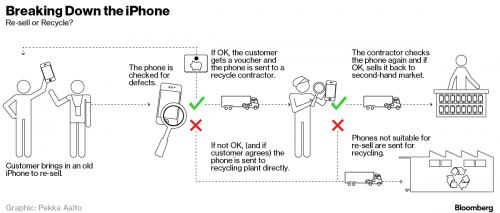Cu ceva timp in urma compania Apple a initiat un program de buy-back prin care le permitea clientilor sa ii dea un smartphone vechi in schimbul unui iPhone nou, ei primind un voucher de reducere pentru cumpararea noului dispozitiv, banii oferiti fiind mult mai putini decati cei pe care o persoana i-ar fi putut primi prin vanzarea second-hand.
In 2014 compania Apple a adunat peste 40.000 de tone de produse care au fost reciclate, iar partenerii celor din Cupertino spun ca afacerea este una foarte profitabila, in principal din cauza cerintelor pe care cei din Cupertino le au pentru acest proces.
Desi in mod normal este mai ieftin sa refolosesti anumite componente ale unui smartphone decat sa il distrugi total, compania Apple prefera sa distruga complet toate iPhone-urile preluate de la clienti pentru a preveni refolosirea pieselor pentru terminale contrafacute vandute pe piata neagra.
In aceasta idee, partenerii care ii recicleaza produsele trebuie sa aiba fabrici dedicate pentru aceasta operatiune, ele fiind pazite constant de oameni care se asigura ca logo-urile Apple dispar de pe fiecare terminal, ca mediile de stocare sunt complet sterse si piesele distruse in totalitate.
Procesul de reciclare al unui iPhone incepe intr-un magazin Apple, sau cel al unui partener, acolo terminalul fiind inspectat de catre un angajat, iar daca dispozitivul poate fi revandut, este trimis spre revanzare, insa daca nu poate fi revandut este trimis la reciclare.
In fabricile de reciclare toate transporturile de iPhone-uri sunt cantarite inainte de a intra in fabrica, apoi dispozitivele sunt deasamblate pentru distrugere separata, rezultatul acestui proces fiind in anumite cazuri folosit pentru a crea alte componente.
Din materia rezultata dupa distrugere sunt extrase anumite materiale care sunt mai apoi sortate si trimise catre topitorii de unde se produc metale sau alte materiale ce sunt folosite mai apoi la producerea altor componente pentru iPhone-uri.
Procedeul in sine este foarte complicat, insa compania Apple l-a initiat pentru a se asigura ca piesele iPhone-urilor vechi nu sunt folosite pentru produse contrafacute care sunt vandute in principal in Asia.























